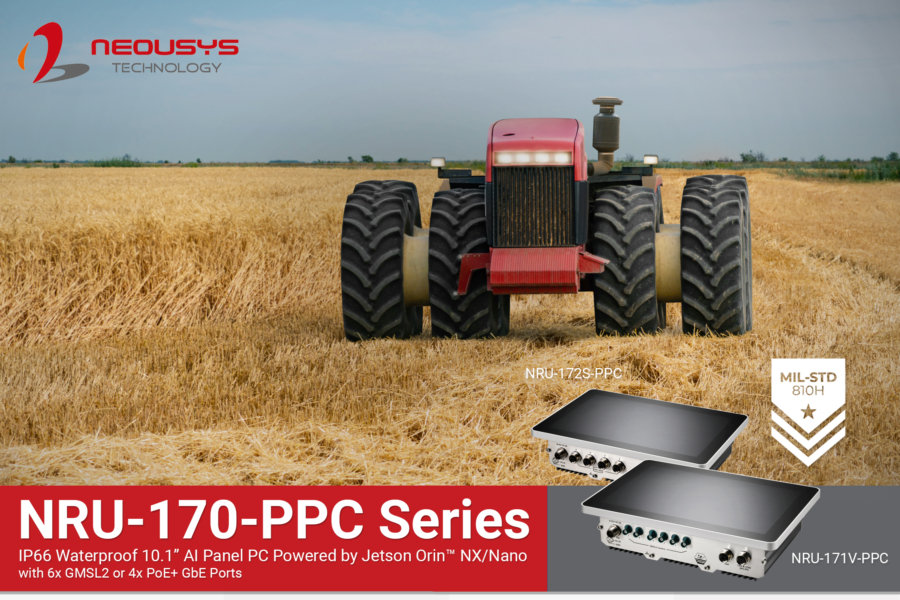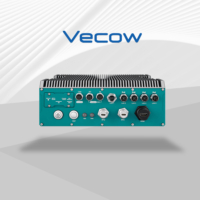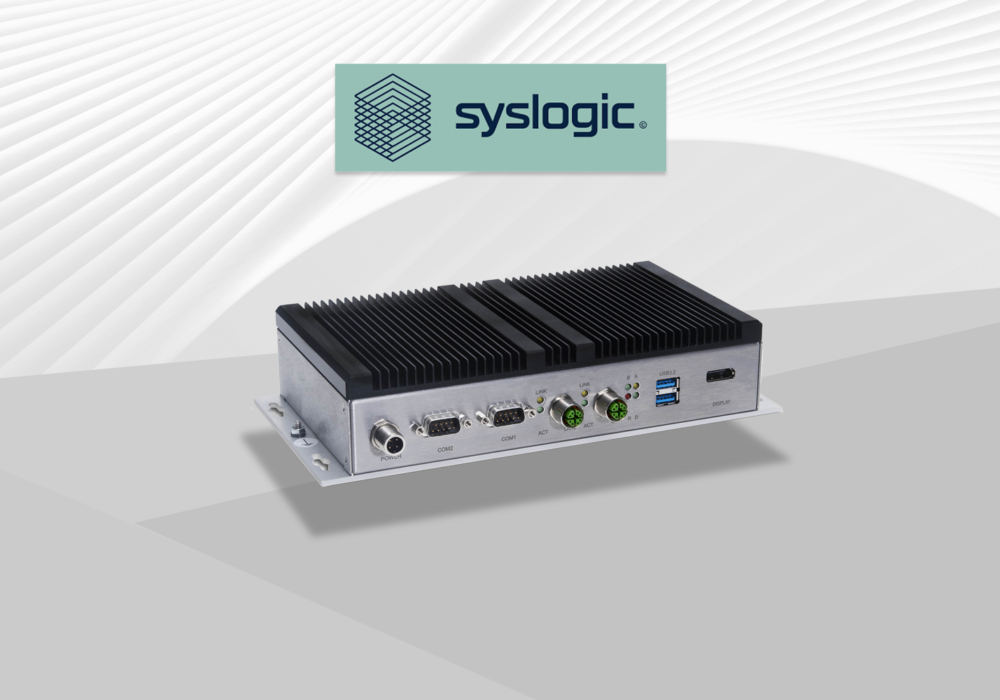In this article:
- Unparalleled Features and Their Benefits
- Applications Across Industries
- Future Trends in Edge AI and Rugged Computing
- Conclusion

Neousys Technology, a leader in rugged edge AI systems, introduces the NRU-171V-PPC and NRU-172S-PPC—the first IP66-certified AI panel PCs powered by NVIDIA® Jetson Orin™ NX or Jetson Orin™ Nano. These groundbreaking systems combine exceptional durability with cutting-edge AI capabilities, designed to operate reliably in harsh environments like off-road vehicles, industrial automation, and outdoor edge AI applications.
With an IP66-certified design, these panel PCs are fully waterproof and dustproof, making them ideal for environments exposed to heavy dust, water spray, or extreme weather conditions. They are particularly well-suited for industries where reliability and performance are critical, such as agriculture, mining, construction, logistics, and manufacturing.
Unparalleled Features and Their Benefits
- IP66 Certification for Rugged Environments
The IP66 rating ensures complete protection against dust and powerful water jets, making the NRU-170-PPC series ideal for deployment in extreme conditions. It offers unparalleled durability in:
- Dusty Construction Sites: Prevents damage caused by fine particles.
- Rainy or Wet Environments: Operates seamlessly in heavy rain or washdown scenarios in industries like food processing.
Benefits:
The IP66-rated design reduces maintenance costs by eliminating the need for additional protective housings. This is particularly valuable in outdoor applications, such as smart farming or vehicle-mounted systems, where equipment is continuously exposed to dirt, mud, and water.
- High-Performance 10.1-Inch Touchscreen
The NRU-170-PPC Series features a 10.1-inch touchscreen designed for semi-outdoor and outdoor use, offering:
- 1000 cd/m² Brightness: Maintains visibility even under direct sunlight.
- 1000:1 Contrast Ratio: Provides sharp and vivid visuals for detailed inspections or real-time monitoring.
- Enhanced Touch Sensitivity: Operates efficiently even in wet conditions, ideal for rainy weather or operations requiring gloves.
Example Use Case:
An autonomous tractor in a wet field can still deliver accurate crop analysis and route planning, ensuring productivity regardless of weather conditions.
- AI Processing Power with NVIDIA Jetson Orin™ NX/Nano
Powered by NVIDIA® Jetson Orin™ NX or Orin™ Nano, the NRU-170-PPC series delivers up to 100 INT8 TOPS, making it capable of processing complex AI tasks like:
- Real-time object recognition and classification.
- Predictive analytics for equipment health.
- Obstacle detection and route optimisation.
Why It Matters:
The Jetson processors offer enterprise-grade performance with low power consumption, enabling mobile AI applications without compromising energy efficiency.
- Versatile Connectivity Options
The NRU-170-PPC series stands out with its advanced connectivity features, including:
- GMSL2 Camera Support: The NRU-171V-PPC supports up to six GMSL2 cameras, ideal for high-speed and long-distance data transmission.
- PoE+ GbE Ports: The NRU-172S-PPC features four PoE+ GbE ports with M12 connectors, allowing seamless integration of industrial IP cameras.
- LiDAR Integration: A waterproof GbE port enables connectivity with LiDAR systems for 3D mapping and obstacle detection.
Benefits:
This comprehensive connectivity makes the NRU-170-PPC Series a versatile solution for industries looking to leverage edge AI technology without overhauling their existing systems.
- Built for Extreme Conditions
The fanless design ensures reliable performance in temperatures ranging from -25°C to 60°C, while its shock and vibration resistance make it suitable for mobile applications in rough terrains, such as:
- Mining Sites: Withstands dusty, hot, and high-vibration environments.
- Construction Equipment: Operates efficiently in rugged terrains and under constant movement.
- Modular Expansion for Customisation
The NRU-170-PPC series supports modular expansion through:
- Mini-PCIe Socket: For adding Wi-Fi, Bluetooth, or additional CAN/COM functionality.
- M.2 B-Key Socket: For integrating 4G LTE or 5G NR modules.
Future-Proof Design:
These modular options allow businesses to upgrade and adapt their systems as technology evolves, ensuring long-term usability and ROI.
MIL-STD-810H Certification: A Benchmark for Durability
One of the standout features of this series is its MIL-STD-810H certification, a rigorous military standard that ensures devices can withstand extreme environmental conditions. Achieving this certification is a testament to the system’s exceptional durability and adaptability in challenging scenarios.
- Resistance to Shock and Vibration: MIL-STD-810H-certified systems are engineered to perform reliably under mechanical stress, such as vibrations from heavy machinery or shocks from rough terrain. This makes them ideal for deployment in off-road vehicles, industrial equipment, and autonomous machines operating in dynamic environments.
- Wide Temperature Range: The certification process includes extensive testing in extreme temperatures, ensuring consistent operation from freezing cold to sweltering heat. This feature is especially beneficial for applications in mining, agriculture, and construction, where systems are exposed to unpredictable weather conditions.
- Dustproof and Waterproof Durability: While the IP66 rating ensures the system’s resistance to water and dust, the MIL-STD-810H certification further validates its ability to function effectively in harsh environments, from sandy deserts to humid rainforests.
- Extended Lifespan: Meeting this stringent standard ensures that the system not only functions in extreme conditions but also maintains its performance and longevity over time. This reduces maintenance costs and downtime, making it a reliable choice for mission-critical operations.
Incorporating MIL-STD-810H certification solidifies the series’ position as a rugged and dependable solution for industries that demand the highest levels of performance and resilience in unforgiving environments.
Applications Across Industries
- Advanced Driver Assistance Systems (ADAS) for Off-road Vehicles
The NRU-170-PPC Series supports GMSL2 and GigE cameras, enabling real-time object detection, collision avoidance, and terrain analysis. This is invaluable for industries such as:
- Smart Agriculture: Monitor crops, detect obstacles, and automate machinery.
- Mining: Navigate complex terrains and avoid hazards with AI-powered vision systems.
- Forestry: Enhance the safety and efficiency of logging equipment.
- Autonomous Mobile Robots (AMRs) and Forklifts
The NRU-170-PPC’s AI capabilities and rugged design make it ideal for powering AMRs in warehouses, manufacturing plants, and outdoor environments.
- Obstacle Detection: Utilises GMSL2 2D/3D cameras to detect obstacles and navigate autonomously.
- Smart Logistics: Facilitates autonomous forklifts for material handling, reducing labour costs and improving efficiency.
- AI Inspection and Quality Control
The waterproof and corrosion-resistant design makes it suitable for harsh environments where AI inspection systems are needed.
- Food and Beverage Industry: Automate quality checks in wet or humid conditions.
- Chemical Processing: Monitor pipelines and detect leaks or irregularities.
- Livestock Management: Deploy AI to monitor animal health and behaviour.
- Agricultural Robotics and UAVs
The NRU-170-PPC series can power AI-driven robots or drones for tasks such as:
- Crop Analysis: Use AI to assess plant health and optimise irrigation.
- Precision Spraying: Ensure chemicals are applied accurately, minimising waste.
- Industrial Automation and Factory IoT
- Smart Manufacturing: Integrate with robotic arms and conveyors for real-time defect detection.
- Predictive Maintenance: Use AI models to predict equipment failures before they occur, reducing downtime.
- Security and Surveillance
With support for multiple cameras and AI inferencing capabilities, the NRU-170-PPC series is ideal for:
- Outdoor Surveillance: Monitor critical infrastructure like dams, oil rigs, and power plants.
- Vehicle-Mounted Security: Deploy in police vehicles for real-time license plate recognition and situational awareness.
Future Trends in Edge AI and Rugged Computing
Future Trends in Edge AI and Rugged Computing
The intersection of edge computing, AI, and ruggedised systems is driving innovation across industries. As these technologies continue to evolve, several emerging trends are expected to shape their application and influence in the coming years.
- Integration with 5G Networks
The global expansion of 5G networks is transforming the way devices communicate, particularly in edge AI applications. Rugged edge systems are poised to capitalise on the benefits of 5G, enabling breakthroughs in performance and connectivity:
- Low-Latency Communication: In mission-critical applications like autonomous vehicles and remote-controlled machinery, ultra-low latency is essential for real-time decision-making. With 5G, these systems can transmit and process data at unprecedented speeds, ensuring seamless operations even in dynamic and high-risk environments.
- High-Bandwidth Applications: 5G facilitates the rapid transmission of large datasets, such as high-definition video streams from multiple cameras or sensors. This is particularly beneficial for tasks like real-time object detection, environmental monitoring, and quality inspection, where fast access to large volumes of data enhances precision and efficiency.
- Edge-Cloud Synergy: The enhanced bandwidth and reliability of 5G enable edge systems to interact seamlessly with cloud platforms. By offloading complex processing tasks to the cloud while maintaining critical functions locally, this hybrid approach reduces latency, minimises costs, and increases operational efficiency.
With the proliferation of 5G, edge AI systems will become integral to applications in smart cities, industrial IoT, and logistics, where robust and high-speed connectivity is paramount.
- Rise of Autonomous Systems
Autonomous technologies are rapidly advancing, with rugged AI systems playing a crucial role in enabling machines to operate independently across various industries:
- Drones and UAVs (Unmanned Aerial Vehicles): In applications such as precision agriculture, infrastructure inspection, and search-and-rescue missions, rugged edge AI systems are vital for real-time navigation, object recognition, and data analysis. Their ability to function in extreme weather conditions makes them well-suited for outdoor use.
- Autonomous Mining and Construction Vehicles: Rugged AI platforms are enabling self-driving vehicles to navigate harsh terrains, optimise routes, and detect obstacles in real-time. This reduces the risk to human operators, increases efficiency, and lowers operational costs in industries like mining, agriculture, and construction.
- Warehouse and Factory Automation: The demand for Autonomous Mobile Robots (AMRs) and automated forklifts is growing in logistics and manufacturing. AI-enabled systems provide advanced vision and decision-making capabilities, enabling efficient material handling, obstacle avoidance, and operational planning.
- Emergency Response and Disaster Recovery: Autonomous robots equipped with rugged AI systems are invaluable in disaster scenarios, where they can navigate hazardous environments, locate survivors, and deliver essential supplies while ensuring operator safety.
As the demand for automation grows, the development and deployment of rugged edge AI systems will play a pivotal role in unlocking the full potential of autonomous technologies.
- AI in Renewable Energy
Ruggedised edge AI systems are increasingly being deployed in the renewable energy sector to optimise operations and ensure reliability:
- Wind Turbine Monitoring: AI-enabled systems analyse real-time data from sensors and cameras on wind turbines, detecting potential issues such as blade damage or alignment problems. This enables predictive maintenance, reduces downtime, and maximises energy output.
- Solar Farm Optimization: In solar farms, AI systems can monitor thermal and visual data to identify faulty panels, shading issues, or dirt accumulation. These insights enable operators to address inefficiencies quickly and ensure consistent energy production.
- Grid Management: Renewable energy grids require precise monitoring to balance energy supply and demand. Edge AI systems process real-time data from energy storage devices, smart meters, and inverters, optimising grid performance and reducing energy losses.
- Offshore Renewable Projects: Offshore wind farms and tidal energy installations operate in harsh marine environments. Rugged AI systems are uniquely capable of handling these conditions while providing critical monitoring and control functionalities.
By integrating AI with renewable energy infrastructure, these systems are contributing to more sustainable and efficient energy solutions, helping the world transition to greener alternatives.
- Growth of Smart Infrastructure
The development of smart infrastructure is another area where rugged AI systems are making significant contributions:
- Smart Traffic Systems: Intelligent transportation systems are leveraging AI to manage traffic flow, detect accidents, and optimise signal timings, reducing congestion and emissions in urban areas.
- Structural Health Monitoring: AI-powered systems are being used to monitor the health of bridges, tunnels, and other critical infrastructure. They analyse data from cameras, sensors, and LiDAR to detect structural weaknesses or environmental hazards, enabling timely maintenance and repairs.
- Construction Site Automation: Rugged edge AI systems are increasingly being deployed on construction sites to enhance worker safety, track equipment usage, and monitor project progress in real-time.
As cities become smarter and more connected, the adoption of these technologies will continue to expand, creating safer and more efficient urban environments.
- Expansion of Industrial IoT (IIoT)
The Industrial Internet of Things (IIoT) is evolving rapidly, with AI-enabled edge systems driving innovation in industrial processes:
- Predictive Maintenance: AI systems analyse real-time sensor data from machinery, identifying potential faults before they occur. This reduces unplanned downtime and extends the lifespan of equipment.
- Quality Control and Inspection: High-speed cameras and AI algorithms are being used in industries like manufacturing and food processing to detect defects in products, ensuring consistent quality and reducing waste.
- Adaptability in Extreme Conditions: Many IIoT applications require systems that can withstand extreme temperatures, vibration, and exposure to dust or moisture. Rugged edge AI systems meet these demands, enabling reliable performance in challenging environments.
- Remote Operations and Monitoring: In industries such as oil and gas or chemical processing, rugged AI systems enable remote monitoring and control of critical operations, improving safety and efficiency.
With the continued integration of AI into industrial IoT ecosystems, these systems are becoming indispensable for enhancing productivity, reducing costs, and enabling smarter operations.
Looking Ahead
The future of rugged computing and edge AI holds immense promise as industries embrace these technologies to meet evolving challenges. From autonomous machines and renewable energy to smart cities and industrial automation, rugged edge AI systems are enabling solutions that are faster, smarter, and more reliable.
By aligning with emerging trends such as 5G, automation, and renewable energy, these systems are not just adapting to change—they are driving it. With their ability to operate in extreme conditions and process data at the edge, they are transforming the way industries operate, ensuring a more connected, efficient, and resilient future.
Conclusion
The NRU-170-PPC series stands as a trailblazer in the rugged AI computing market, redefining the possibilities for edge AI applications in challenging and demanding environments. Its IP66-certified enclosure, NVIDIA Jetson Orin™ NX/Nano processors, and a rich array of connectivity options offer businesses a robust, adaptable, and high-performing solution for tackling the complexities of real-world operations. By enabling seamless integration of AI in industries where traditional systems fall short, this innovative panel PC series empowers companies to embrace digital transformation like never before.
What sets the NRU-170-PPC series apart is its ability to seamlessly combine rugged design with cutting-edge AI capabilities, bridging the gap between theoretical AI advancements and practical industrial deployments. Its versatility makes it invaluable across a broad spectrum of industries, from smart agriculture and construction automation to logistics, security, and food processing. By harnessing the power of AI-driven automation, businesses can unlock new levels of efficiency, accuracy, and sustainability—a crucial factor in today’s competitive and environmentally conscious marketplace.
The NRU-170-PPC series also addresses key operational pain points faced by industries operating in harsh or remote environments. Its wide operating temperature range, shock and vibration resistance, and dustproof and waterproof design ensure uninterrupted performance, even in the most unforgiving conditions. For industries like mining, where downtime can cost millions, or agriculture, where operations are time-sensitive and weather-dependent, the reliability offered by this system is not just a convenience—it’s a game-changer.
Furthermore, the NRU-170-PPC series’ emphasis on connectivity and scalability reinforces its position as a forward-thinking solution. By supporting GMSL2 automotive cameras, PoE+ GbE cameras, and expansion modules for 4G LTE/5G NR communication, it provides the flexibility to adapt to evolving technological needs. This future-proof design ensures that businesses investing in the NRU-170-PPC series are not just solving today’s challenges but are also preparing for the demands of tomorrow.
Its application in autonomous systems, particularly in off-road ADAS for vehicles in agriculture, forestry, mining, and construction, showcases how AI can enhance safety, productivity, and precision in industries historically dependent on manual labor and analog technologies. For example, the NRU-170-PPC series enables real-time obstacle detection and route optimisation, helping operators work faster and smarter while reducing risks to both equipment and personnel.
The series also underscores the broader role of rugged AI systems in driving sustainability. Whether by enabling smart farming practices that reduce resource wastage, predictive maintenance that minimises energy consumption, or autonomous operations that reduce emissions, the NRU-170-PPC Series aligns perfectly with global efforts to promote sustainable development in industrial operations.
Ultimately, the NRU-170-PPC Series is more than just a piece of hardware; it represents a paradigm shift in how businesses approach automation and AI deployment in the field. By removing the limitations of harsh environments and enabling AI to operate at the edge, Neousys Technology has created a platform that empowers industries to innovate and thrive. As organizations continue to navigate the challenges of the modern industrial landscape, the NRU-170-PPC series offers a glimpse into a future where technology and resilience go hand in hand.
For businesses looking to push the boundaries of what’s possible in edge AI, the NRU-170-PPC series is not just a solution—it’s the foundation for a smarter, safer, and more efficient future.










